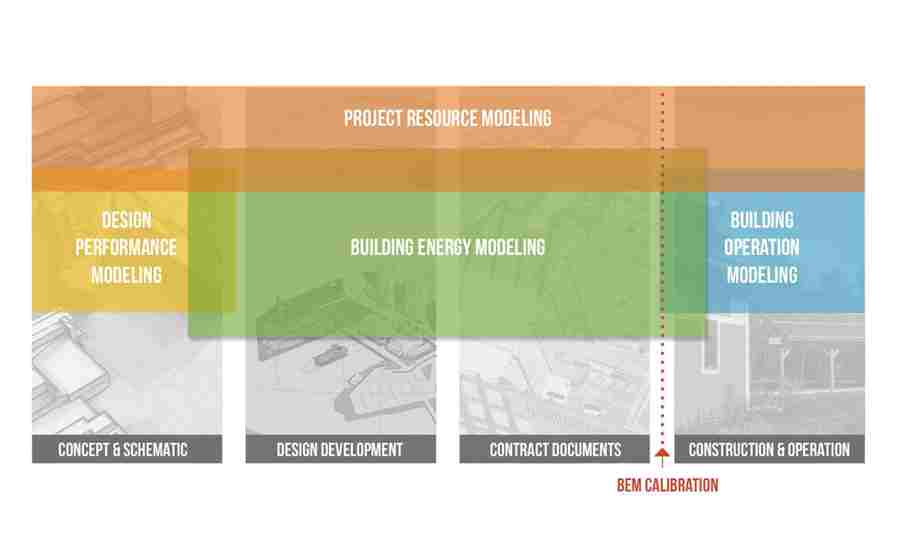The publication An Architect’s Guide to Integrating Energy Modeling in the Design Process is a comprehensive (and free) 86-page document from the American Institute of Architects (AIA) that defines the fundamentals of energy modeling, outlines the current state of various performance and analysis tools, and foretells the direction of an architectural industry increasingly focused on performance-based design.
Among other components of the document, the guide offers:
- A succinct introduction to many key terms related to energy modeling.
- Clarifications related to common misunderstandings about energy modeling.
- An outline of the cycle of benefits energy modeling enables throughout the design process.
- Several potential new and ongoing service opportunities for professionals well versed with energy modeling.
- A summary of the most palatable energy modeling tools in the market today.
In the simplest of definitions, the guide defines an energy model as “a calculation engine that accepts inputs such as building geometry, system characteristics, and operations schedules and produces outputs such as performance comparisons and compliance reports.” However, the guide acknowledges that the language surrounding energy and resource modeling can be confusing and that “energy modeling” can mean different things to project teams at different points in the design process. As such, it differentiates the four most common types of energy/performance modeling as follows:
|
Illustration adapted from "An Architect's Guide to Integrated Energy Modeling in the Design Process," p. 8. |
Design Performance Modeling (DPM)
During the conceptual and schematic design phases, Design Performance Modeling (DPM) informs decision-making by predicting project performance with respect to energy efficiency, daylighting, thermal comfort, natural ventilation and other factors. Typically deployed before engineering systems are fully specified, this level of analysis is less complicated and time-consuming than the more robust Building Energy Modeling. DPM fosters rapid, iterative exploration of various design solutions and allows cost, aesthetics and performance to be given value and considered among the project team and with the client – in real-time in some instances.
Building Energy Modeling (BEM)
Building Energy Modeling (BEM) entails a robust, comprehensive modeling exercise that simulates a project’s anticipated energy use (and corresponding energy savings) as compared to a baseline condition. As such, BEM also demonstrates project compliance with codes and/or third-party certification programs. BEM is a level of modeling that most professionals think of when using the term “energy modeling” and it typically begins during the design development phase and is finalized concurrent with contract documents. BEM models are highly-detailed, incorporating specific design values, mechanical equipment specifications, and assumptions about building operation and maintenance. BEM predicts annual energy performance based on Typical Meteorological Year (TMY) data.
Building Operation Modeling (BOM)
During the construction and operation phases of a project’s development, the BEM model can be calibrated based on data gather regarding actual utility bills, occupant use patterns, hour of operations, functioning of systems, and actual onsite weather conditions. Building Operation Modeling (BOM) is the embodiment of this “fine-tuning” of the energy model. The process of comparison of the BEM and the BOM is known as “calibrated simulation” and is the essence of Measurement & Verification protocol. BOM has utility with regard to satisfying certain code requirements for post-occupancy monitoring. It can also be leveraged to analyze the value proposition of potential facility and/or operational improvements on a project.
Project Resource Modeling (PRM)
Project Resource Modeling (PRM) entails an extensive modeling exercise to assess multiple resource issues related to the development of a project. PRM constitutes a broad effort that can begin during conceptual design and may continue through occupancy. It may address issues reaching far beyond a building’s site energy including water consumption, solid waste, transportation, manufacturing, social and agricultural elements, embodied energy, and carbon emissions among many other factors. PRM can assess existing and imported resources and can help teams better understand the interrelationships among resources.
To download An Architect’s Guide to Integrating Energy Modeling in the Design Process, visit: https://www.aia.org/resources/8056-architects-guide-to-integrating-energy-modeling



Recent Comments
These are actually very helpful tips. It is...
This is the most beneficial blog for all...
This blog is a great resource for anyone...
Thank you for sharing this important information. I...
This is a very interesting subject of the...